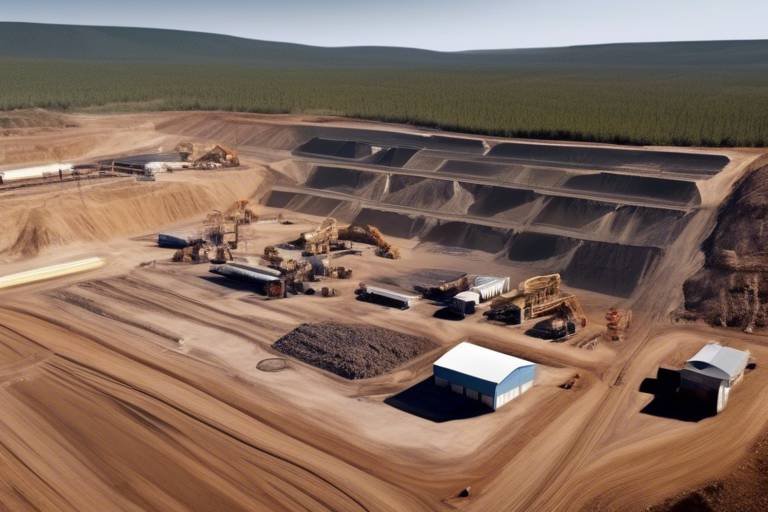Understanding the Relationship Between Market Cap and Growth
When diving into the world of finance, one of the most intriguing relationships to explore is that between market capitalization and company growth. But what exactly does this mean? Market capitalization, often referred to as market cap, is essentially the total market value of a company's outstanding shares of stock. It's a crucial metric that investors use to gauge the size and health of a company. But how does this number influence a company's growth trajectory? And conversely, how does growth impact market cap?
To put it simply, the relationship is somewhat like a dance; they influence each other in a continuous cycle. As a company grows—whether through increased revenues, expanding customer bases, or innovation—its market cap often rises in tandem. This correlation is vital for investors to understand, as it can provide insights into the potential future performance of a company. Imagine it as a rising tide that lifts all boats; as the company flourishes, so does its perceived value in the eyes of investors.
However, this relationship is not as straightforward as it may seem. Various factors come into play, including market sentiment, industry trends, and economic conditions. For instance, a tech startup may experience rapid growth, but if the market sentiment is negative, its stock price—and consequently, its market cap—may not reflect that growth. This dynamic can create confusion for investors trying to navigate the waters of the stock market.
Moreover, different sectors can exhibit unique growth patterns that affect market cap differently. A booming tech sector may see companies with high market caps due to rapid innovation and consumer demand, while traditional industries may not experience the same explosive growth. Understanding these nuances is crucial for investors looking to make informed decisions.
In this article, we will delve deeper into the intricate relationship between market cap and growth, exploring the various factors that influence this dynamic and what it means for investors and the broader economy. By the end, you’ll have a clearer understanding of how these two concepts interact and why they matter in the ever-evolving financial landscape.
Market capitalization is a key financial metric that represents the total market value of a company's outstanding shares. Understanding its calculation and significance is crucial for assessing a company's financial health. Market cap is calculated by multiplying the current share price by the total number of outstanding shares. For example, if a company has 1 million shares outstanding, and each share is priced at $50, its market cap would be $50 million. This figure serves as a quick reference for investors to gauge the size of the company relative to its competitors.
Market cap is often categorized into three main segments:
- Large-cap: Companies with a market cap of $10 billion or more, typically considered stable and reliable.
- Mid-cap: Companies with a market cap between $2 billion and $10 billion, often seen as growth-oriented.
- Small-cap: Companies with a market cap of less than $2 billion, usually associated with higher risk but also higher potential returns.
Understanding these categories helps investors tailor their strategies based on their risk tolerance and investment goals. Large-cap companies may offer stability, while small-cap firms can present exciting growth opportunities. However, it's essential to remember that market cap alone doesn't tell the whole story; it's just one piece of the puzzle.
Company growth directly impacts market cap, as increasing revenues and profits typically lead to a higher stock price. This section discusses the correlation between growth metrics and market valuation. Investors closely monitor growth indicators such as revenue growth and earnings growth to assess a company's potential. A company that consistently grows its revenue often attracts more investors, driving up its stock price and, consequently, its market cap.
While both revenue and earnings growth are important, they can influence market cap differently. Revenue growth reflects the company's ability to increase sales, while earnings growth indicates profitability. Investors often weigh these growth types based on their investment strategies. For instance, a tech startup might focus on rapid revenue growth to capture market share, even if it means operating at a loss initially. In contrast, established companies may prioritize earnings growth to ensure consistent dividends for shareholders.
Market sentiment can significantly affect how growth is perceived, impacting stock prices and market cap. Positive news, such as a successful product launch, can lead to a surge in stock prices, while negative headlines can have the opposite effect. This psychological aspect of investing is crucial, as it can lead to volatility in market cap that doesn't necessarily reflect the company's underlying performance.
Different sectors experience unique growth trends that can influence market cap differently. For example, the technology sector often sees rapid growth due to innovation, whereas more traditional sectors like utilities may grow at a slower, steadier pace. Understanding these industry characteristics is vital for investors looking to navigate the stock market effectively.
Valuation metrics such as P/E ratios and price-to-sales ratios help investors assess a company's market cap relative to its growth potential. These metrics provide insights into whether a stock is overvalued or undervalued, guiding investment decisions. For instance, a company with a high P/E ratio may indicate that investors expect significant growth, while a low ratio could suggest the opposite.
Investing in companies with high market caps carries specific risks, including market volatility and overvaluation. This section highlights potential pitfalls investors should be aware of. While large-cap companies may appear safer, they can still be subject to market corrections that lead to significant losses.
Market corrections can disproportionately affect high market cap companies, leading to significant losses. Historical examples, such as the dot-com bubble, illustrate how quickly market sentiment can shift, resulting in rapid declines in market cap. Understanding these risks is essential for investors, as it can help them make more informed decisions about their portfolios.
Different investment strategies can yield varying impacts on market cap. Focusing on long-term growth may lead to steady increases in market cap, while short-term strategies can result in volatility. Investors must weigh the trade-offs between these approaches and consider their financial goals before diving into the market.
- What is market capitalization?
Market capitalization is the total market value of a company's outstanding shares of stock. - How does growth affect market cap?
As a company grows in revenue and profits, its stock price typically increases, leading to a higher market cap. - What are the risks of investing in high market cap companies?
High market cap companies can face significant risks, including market volatility and potential overvaluation.

The Basics of Market Capitalization
Market capitalization, often referred to as market cap, is a key financial metric that provides insight into the total market value of a company's outstanding shares. It is calculated by multiplying the current share price by the total number of outstanding shares. For instance, if a company has 1 million shares outstanding, and each share is priced at $50, the market cap would be $50 million. This simple calculation is crucial for investors as it helps them gauge a company's size and its position within the market.
Understanding market cap is essential for assessing a company's financial health. Companies are typically categorized into three main groups based on their market capitalization:
- Large-cap: Companies with a market cap of $10 billion or more. These firms are often industry leaders and are considered stable investments.
- Mid-cap: Companies with a market cap between $2 billion and $10 billion. They are generally seen as having more growth potential than large-cap companies but also carry more risk.
- Small-cap: Companies with a market cap of less than $2 billion. These firms can offer significant growth opportunities, but they also come with higher volatility and risk.
But why does market cap matter? Well, it serves as an indicator of a company's size, which in turn can influence its investment risk and potential for growth. Generally, larger companies tend to have a more established market presence and can weather economic downturns better than smaller firms. However, smaller companies might offer higher growth rates as they expand their operations. This dynamic creates a fascinating tug-of-war for investors trying to balance risk and reward.
Moreover, market capitalization can affect a company's access to capital. Larger companies often find it easier to raise funds through equity or debt markets due to their established reputation and stability. In contrast, smaller firms may struggle to secure financing, which can limit their growth potential. This relationship between market cap and capital access further emphasizes the importance of understanding market capitalization in the context of company growth.
In summary, market capitalization is not just a number; it is a reflection of a company's size, stability, and growth potential. Investors should consider market cap alongside other financial metrics to make informed decisions and develop a comprehensive understanding of a company's position in the market.
- What is market capitalization? Market capitalization is the total market value of a company's outstanding shares, calculated by multiplying the share price by the number of outstanding shares.
- Why is market cap important? Market cap helps investors assess a company's size, stability, and growth potential, influencing their investment decisions.
- How do companies get categorized by market cap? Companies are categorized as large-cap, mid-cap, or small-cap based on their market capitalization, which affects their risk and growth potential.

How Growth Affects Market Cap
When we talk about the relationship between **growth** and **market capitalization**, it's like discussing the bond between a tree and its roots. Just as a tree flourishes when its roots are strong and well-nourished, a company's market cap tends to rise when it experiences robust growth. This growth can manifest in various forms, such as increasing revenues, expanding customer bases, or boosting profits. Investors often view these indicators as signals of a company's potential, leading to higher stock prices and, consequently, an increased market cap.
To put it simply, when a company grows, it becomes more valuable in the eyes of investors. Imagine you own a small bakery that starts selling a new line of pastries. If your sales skyrocket, not only will your profits increase, but your bakery's perceived value will rise as well. This is akin to how companies operate in the stock market; as they grow, their market cap reflects that growth, drawing in more investors and often leading to a virtuous cycle of rising stock prices.
However, growth doesn't just happen in a vacuum. There are several factors at play that can either accelerate or hinder this relationship:
- Revenue Growth: This is often the first thing investors look at. A steady increase in sales can lead to higher market cap as it signals demand for the company's products or services.
- Earnings Growth: While revenue is essential, earnings—what remains after costs—are crucial for assessing profitability. Companies that manage to grow their earnings effectively often see a more favorable market cap adjustment.
- Market Sentiment: This is the psychological aspect of investing. Sometimes, even if a company has solid growth metrics, negative news or market trends can dampen investor enthusiasm, impacting its market cap.
Additionally, the correlation between growth metrics and market cap can vary significantly across different sectors. For instance, technology firms may experience rapid growth due to innovation, while traditional industries might see slower, steadier growth patterns. This variance means that investors need to be savvy and consider the broader economic landscape and sector-specific trends when evaluating a company's potential.
In summary, the interplay between growth and market cap is dynamic and multifaceted. As companies grow, their market cap often rises in tandem, propelled by strong revenue and earnings growth, market sentiment, and sector-specific characteristics. Understanding this relationship can help investors make informed decisions about where to allocate their resources in the ever-evolving financial landscape.
- What is market capitalization? Market capitalization is the total market value of a company's outstanding shares, calculated by multiplying the stock price by the total number of shares.
- How does revenue growth affect market cap? Revenue growth can lead to increased investor confidence, resulting in higher stock prices and, consequently, a larger market cap.
- Can market sentiment impact a company's growth? Absolutely! Positive or negative sentiment can influence investor behavior, affecting stock prices and market cap even if the company's fundamentals are strong.
- Are there risks associated with investing in high market cap companies? Yes, high market cap companies can be more susceptible to market corrections and may be overvalued, posing risks for investors.

Revenue Growth vs. Earnings Growth
When it comes to assessing a company’s financial health and potential for future success, two key metrics often come into play: revenue growth and earnings growth. While they may seem similar at first glance, they tell very different stories about a company’s performance and prospects. Think of revenue as the lifeblood of a business, while earnings are the nutrients that sustain it. Revenue growth indicates how well a company is generating sales, while earnings growth reflects how effectively it is turning those sales into profit.
Investors often find themselves in a dilemma: should they prioritize revenue growth or earnings growth when evaluating a company? The answer isn’t straightforward, as both metrics have their own merits and implications. For instance, a company experiencing rapid revenue growth may be investing heavily in expansion, which could lead to lower earnings in the short term. On the flip side, a company with steady earnings growth may not be maximizing its sales potential, raising questions about its long-term viability.
To illustrate this dynamic, let’s consider a hypothetical tech startup. Imagine TechCo, which has recently launched a groundbreaking app. In its first year, TechCo reports a staggering 200% revenue growth as users flock to download the app. However, due to high marketing expenses and development costs, the company reports a net loss, indicating zero earnings growth. Investors might be excited about the revenue figures but concerned about the lack of profitability.
Conversely, let’s look at a well-established company like BigCorp, which has a stable product line and a loyal customer base. BigCorp’s revenue growth is modest at around 5% annually, but its earnings growth is robust at 15% annually. This suggests that BigCorp is efficiently managing its costs and maximizing its profits, making it a potentially safer investment.
In essence, both revenue and earnings growth are crucial, but they serve different purposes. Revenue growth can signal potential and market demand, while earnings growth can indicate operational efficiency and profitability. Investors must weigh these factors carefully, often looking at both metrics in conjunction with other indicators like market sentiment and sector performance.
To further clarify the differences, here's a simple table summarizing the key aspects of revenue growth and earnings growth:
| Aspect | Revenue Growth | Earnings Growth |
|---|---|---|
| Definition | Increase in sales over time | Increase in net profit over time |
| Significance | Indicates market demand and expansion potential | Indicates operational efficiency and profitability |
| Short-term Impact | Can lead to high valuations despite losses | Can lead to stable valuations with potential for dividends |
| Long-term Impact | May lead to profitability if managed well | Indicates sustainable business practices |
Ultimately, understanding the relationship between revenue growth and earnings growth is essential for making informed investment decisions. Investors should not only focus on one metric but also consider how they interact with each other and the overall market conditions. After all, a company that can balance both effectively is likely to thrive in the long run.
- What is more important, revenue growth or earnings growth?
It depends on the context. Revenue growth indicates market demand, while earnings growth shows profitability. Both are important for a complete picture of a company's health. - Can a company have high revenue growth but low earnings?
Yes, this can happen, especially in startups that invest heavily in growth initiatives. - How do investors assess revenue and earnings growth?
Investors typically look at both metrics in conjunction with other financial indicators and market conditions to gauge a company's overall performance.

The Role of Market Sentiment
Market sentiment plays a crucial role in shaping the dynamics of financial markets, acting like a powerful undercurrent that can either propel a company’s stock price to new heights or drag it down into the depths of despair. But what exactly is market sentiment? Essentially, it refers to the overall attitude of investors toward a particular security or financial market. This sentiment can be influenced by a myriad of factors, including economic indicators, news events, and even social media chatter.
Imagine market sentiment as the mood of a crowd at a concert. When the music is upbeat, everyone is dancing and having a great time, much like when investors are optimistic about a company’s future. Conversely, if the band hits a sour note, the crowd's energy can plummet, mirroring how negative news can cause investors to panic sell. This psychological aspect of investing often leads to irrational behavior, which can significantly impact a company's market cap.
One of the most fascinating aspects of market sentiment is its ability to create self-fulfilling prophecies. When a company reports strong earnings, the positive sentiment can lead to increased buying pressure, pushing the stock price higher. This, in turn, can attract more investors, further driving up the price. On the flip side, negative sentiment can lead to a downward spiral, where fear and uncertainty lead to selling, which then causes the stock price to drop even further.
In today’s fast-paced digital world, where information spreads like wildfire, market sentiment can shift in the blink of an eye. Social media platforms and financial news outlets can amplify sentiments, causing stocks to react swiftly to rumors or news. It’s essential for investors to be aware of these fluctuations and understand that market sentiment often doesn’t reflect a company’s fundamental value. For instance, a company with solid fundamentals might see its stock price plummet due to negative sentiment, creating a potential buying opportunity for savvy investors.
To illustrate the impact of market sentiment, consider the following table that highlights the correlation between positive sentiment and stock performance:
| Company | Market Sentiment | Stock Performance |
|---|---|---|
| Tech Innovators Inc. | Positive | +25% |
| Healthcare Solutions LLC | Negative | -15% |
| Green Energy Corp. | Neutral | +5% |
As seen in the table, Tech Innovators Inc. experienced a notable rise in stock performance due to positive market sentiment, while Healthcare Solutions LLC suffered a decline as negative sentiment took hold. This showcases how critical it is for investors to stay attuned to the prevailing mood in the market, as it can often dictate short-term price movements.
In conclusion, understanding the role of market sentiment is essential for investors looking to navigate the complexities of the stock market. It’s not just about the numbers; it’s about the emotions and perceptions that drive those numbers. By keeping a finger on the pulse of market sentiment, investors can make more informed decisions that align with their investment strategies.
- What is market sentiment? Market sentiment refers to the overall attitude of investors toward a particular security or financial market, influenced by various factors such as news and economic indicators.
- How does market sentiment affect stock prices? Positive sentiment can drive stock prices up, while negative sentiment can lead to declines, often regardless of a company's fundamental value.
- Can market sentiment change quickly? Yes, in today's digital age, market sentiment can shift rapidly due to the instantaneous spread of information via social media and news outlets.

Sector-Specific Growth Trends
When it comes to understanding how market capitalization interacts with growth, it's essential to consider the unique characteristics of different sectors. Each industry has its own dynamics and growth drivers, which can significantly influence how investors perceive value and potential. For instance, the technology sector often experiences rapid growth due to innovation and consumer demand, leading to higher market caps. In contrast, sectors like utilities or consumer staples tend to grow at a slower pace, but they often provide stability and consistent dividends, appealing to risk-averse investors.
One of the most fascinating aspects of sector-specific growth trends is how external factors can create disparities in growth rates. Economic conditions, regulatory changes, and technological advancements can all play a role. For example, during an economic boom, sectors like travel and hospitality may see substantial growth as disposable income increases, while luxury goods may also thrive. Conversely, in a recession, these sectors often suffer while others, such as discount retailers or essential services, may experience growth as consumers tighten their budgets.
To illustrate this point further, consider the following table, which highlights the average growth rates of various sectors over the past five years:
| Sector | Average Growth Rate (%) |
|---|---|
| Technology | 15% |
| Healthcare | 10% |
| Consumer Discretionary | 7% |
| Utilities | 4% |
| Consumer Staples | 5% |
As seen in the table, technology leads the pack with an average growth rate of 15%, which is a clear reflection of the sector's capacity for innovation and disruption. On the other hand, utilities and consumer staples show more modest growth rates, highlighting their role as stable investments rather than high-growth opportunities. Investors need to align their investment strategies with these sector-specific trends to optimize their portfolios effectively.
Moreover, it's crucial to recognize that within each sector, individual companies can have varying growth trajectories based on their unique strategies, management, and market positioning. A tech company that successfully launches a groundbreaking product can see its market cap soar, while another that fails to innovate may lag behind, regardless of the overall sector's performance. This showcases the importance of not just looking at sector averages but also delving deeper into company fundamentals.
In conclusion, sector-specific growth trends play a pivotal role in shaping market capitalization and investor sentiment. By understanding these trends, investors can make more informed decisions that align with their risk tolerance and investment goals. The interplay between market cap and growth is not just a numbers game; it’s about recognizing the broader economic landscape and how different sectors respond to it.
- What is market capitalization? Market capitalization is the total market value of a company's outstanding shares, calculated by multiplying the share price by the total number of shares.
- How does growth affect market cap? As a company's revenues and profits increase, its stock price usually rises, leading to a higher market cap.
- Why are sector-specific trends important? Different sectors grow at different rates due to unique economic factors, and understanding these trends helps investors make better decisions.
- What risks are associated with investing in high market cap companies? Risks include market volatility and the potential for overvaluation, which can lead to significant losses during market corrections.

Valuation Metrics and Market Cap
When diving into the world of investing, understanding the relationship between valuation metrics and market capitalization is crucial. These metrics serve as the compass by which investors navigate the sometimes turbulent waters of stock valuation. At its core, market capitalization is a reflection of a company’s total market value, determined by multiplying the stock price by the total number of outstanding shares. But how do we determine if that market cap is justified? This is where valuation metrics come into play.
One of the most commonly used valuation metrics is the Price-to-Earnings (P/E) ratio. This ratio compares a company's current share price to its earnings per share (EPS), providing investors with insight into how much they are willing to pay for each dollar of earnings. A high P/E ratio might indicate that investors expect high growth rates in the future, while a low P/E ratio could suggest that the stock is undervalued or that the company is experiencing difficulties. However, it’s essential to compare P/E ratios within the same industry, as different sectors have varying average ratios.
Another important metric is the Price-to-Sales (P/S) ratio. This ratio is particularly useful for companies that are not yet profitable. By comparing the company’s market cap to its total sales, investors can gauge how much they are paying for each dollar of revenue. A lower P/S ratio may indicate that the stock is undervalued, especially in sectors where growth is expected. However, just like the P/E ratio, it’s crucial to consider industry standards when evaluating this metric.
For a more comprehensive analysis, investors often look at a combination of these metrics. For instance, a company with a high P/E ratio but a low P/S ratio might be experiencing growing pains that investors are willing to overlook due to its potential for future earnings. Conversely, a company with a low P/E ratio and a high P/S ratio might be undervalued but struggling to convert sales into profit.
| Valuation Metric | Formula | Insight |
|---|---|---|
| Price-to-Earnings (P/E) Ratio | Current Share Price / Earnings Per Share (EPS) | Indicates how much investors are willing to pay for a dollar of earnings. |
| Price-to-Sales (P/S) Ratio | Market Capitalization / Total Sales | Shows how much investors are paying for each dollar of revenue. |
In addition to P/E and P/S ratios, investors may also consider the Price-to-Book (P/B) ratio, which compares a company’s market value to its book value. This metric is particularly useful for evaluating companies with substantial physical assets, such as real estate or manufacturing firms. A P/B ratio under 1 might suggest that the stock is undervalued, as the market price is less than the company's net asset value.
Ultimately, using these valuation metrics in conjunction with market capitalization provides a more rounded perspective of a company's financial health and growth potential. Investors should remember that these metrics are not foolproof; they should be used as part of a broader investment strategy that includes qualitative factors such as market conditions, management effectiveness, and sector trends. The interplay between market cap and these valuation metrics is like a dance—each step must be carefully considered to ensure a balanced and informed investment decision.
- What is market capitalization? Market capitalization is the total market value of a company's outstanding shares, calculated by multiplying the stock price by the number of shares.
- Why are valuation metrics important? Valuation metrics help investors assess whether a company's stock is fairly valued compared to its earnings, sales, and assets.
- How do I use P/E and P/S ratios? Use P/E ratios to evaluate earnings relative to the stock price, and P/S ratios to assess revenue relative to market cap. Compare these ratios to industry averages for context.

Risks Associated with High Market Cap
Investing in companies with a high market capitalization can seem like a safe bet. After all, these companies are often leaders in their industries, boasting substantial resources and a track record of success. However, it's essential to recognize that with great size comes significant risk. One of the primary dangers is market volatility. High market cap companies can be subject to sudden price swings, often influenced by broader market trends or economic shifts. This volatility can lead to substantial losses for investors who may not be prepared for such fluctuations.
Another critical risk is overvaluation. As a company's market cap increases, there's a tendency for its stock price to reflect expectations of continued growth. If a company fails to meet these expectations, the stock price can plummet, leaving investors in a precarious position. It's akin to building a house on a shaky foundation; it may look impressive at first, but one misstep could lead to a collapse. Investors must be vigilant and conduct thorough analyses to avoid falling into the trap of investing in overhyped stocks.
Moreover, high market cap companies can become complacent. When a company reaches a certain level of success, it may stop innovating, believing that its current market position is secure. This stagnation can open the door for smaller, more agile competitors to swoop in and capture market share. In this sense, investing in a high market cap company can sometimes feel like betting on a horse that has already run its race; it may have been a champion, but it could also be on the decline.
Additionally, the concentration of wealth in high market cap stocks can lead to systemic risks in the economy. If a few large companies dominate the market, any downturn in their performance can have a ripple effect, impacting not just individual investors but the economy as a whole. This situation highlights the importance of diversification in an investment portfolio. By spreading investments across various sectors and market capitalizations, investors can mitigate the risks associated with any single company's performance.
In summary, while high market cap companies may offer an aura of stability and reliability, they come with their own set of risks. From market volatility and overvaluation to complacency and systemic risks, investors must remain vigilant and informed. As the saying goes, "don't put all your eggs in one basket." Diversifying your investments can be a smart strategy to navigate the complexities of the stock market.
- What is market capitalization?
Market capitalization is the total market value of a company's outstanding shares, calculated by multiplying the current share price by the total number of outstanding shares. - Why is a high market cap considered risky?
A high market cap can indicate overvaluation and susceptibility to market volatility, making it risky for investors if the company fails to meet growth expectations. - How can I mitigate risks associated with high market cap investments?
Diversifying your investment portfolio by including a mix of different market caps and sectors can help reduce risk. - What should I look for in high market cap stocks?
Consider looking for companies with solid fundamentals, a history of innovation, and a competitive edge in their industry.

Market Corrections and Their Impact
Market corrections are a natural part of the investment landscape, often sending shivers down the spines of even the most seasoned investors. These corrections, defined as a decline of 10% or more in stock prices from recent highs, can have a profound impact on companies, particularly those with high market capitalizations. Imagine a balloon that is inflated too much; eventually, it reaches a point where it must pop, and that’s akin to what happens during a market correction.
High market cap companies, often seen as safe bets, can experience significant volatility during these corrections. When the market takes a downturn, investors may panic, leading to a sell-off that disproportionately affects larger companies. For instance, during the dot-com bubble burst in the early 2000s, many tech giants saw their valuations plummet as investor sentiment shifted dramatically. A similar pattern was observed during the 2008 financial crisis, where even the most robust companies faced steep declines in their stock prices.
To provide a clearer picture, let's look at the historical performance of high market cap companies during notable market corrections:
| Market Correction | Year | Average Decline (%) | Impact on High Market Cap Companies |
|---|---|---|---|
| Dot-com Bubble Burst | 2000-2002 | -78% | Many tech giants lost over 50% of their value |
| Financial Crisis | 2007-2009 | -57% | Major banks and financial institutions faced severe drops |
| COVID-19 Market Crash | 2020 | -34% | Even established companies saw sharp declines in stock prices |
These examples illustrate that while high market cap companies are often perceived as stable, they are not immune to the forces of market corrections. The psychological aspect of investing plays a significant role here; when fear grips the market, even the most resilient companies can see their stock prices drop dramatically. This can lead to a vicious cycle where declining prices trigger further selling, exacerbating the situation.
Understanding the implications of market corrections is essential for investors. While it may seem tempting to panic and sell during these downturns, a more strategic approach could involve reassessing the fundamentals of the companies in question. Are they still fundamentally strong? Do they have a solid plan for recovery? By asking these questions, investors can better navigate the turbulent waters of market corrections.
In conclusion, while market corrections can be daunting, they also provide opportunities for savvy investors to acquire shares at lower prices. The key is to remain calm, stay informed, and make decisions based on research rather than emotion. After all, just like the weather, the market is cyclical, and what goes down must eventually come back up.
- What is a market correction? A market correction is a decline of 10% or more in stock prices from recent highs.
- How do market corrections affect high market cap companies? High market cap companies can experience significant volatility during corrections, leading to sharp declines in their stock prices.
- Should I sell my stocks during a market correction? It depends on the fundamentals of the company. It's often better to assess the situation rather than panic sell.
- Can market corrections present investment opportunities? Yes, corrections can offer chances to buy shares at lower prices if the company's fundamentals remain strong.

Long-Term vs. Short-Term Growth Strategies
When it comes to investing, the debate between long-term and short-term growth strategies is as old as the markets themselves. Imagine you're at a buffet: you can either fill your plate with a little bit of everything for immediate satisfaction or choose to savor a few select dishes that promise more flavor over time. Similarly, investors must decide whether to chase quick gains or to cultivate a portfolio that flourishes over the long haul.
Long-term growth strategies focus on building wealth gradually, often through investments in companies with strong fundamentals, innovative products, and sustainable business models. Think of it as planting a tree. At first, it may seem slow to grow, but with time, it can provide shade and fruit for years to come. This approach typically involves analyzing a company's potential for future earnings, market position, and overall economic conditions. Investors who adopt this strategy are usually more patient, willing to ride out market fluctuations in hopes of substantial returns down the line.
On the flip side, short-term growth strategies can be likened to a sprint. Investors who prefer this approach often seek to capitalize on market trends, news events, or seasonal patterns. They buy and sell quickly, aiming to make profits from short-lived opportunities. This strategy can be lucrative, especially in volatile markets, but it also comes with its own set of risks. Just as a sprinter can tire out quickly, short-term investors may find themselves exhausted by the constant need to monitor their investments, leading to stress and potential losses.
To illustrate the differences, let's take a look at a comparison table:
| Aspect | Long-Term Growth Strategies | Short-Term Growth Strategies |
|---|---|---|
| Investment Horizon | Years to decades | Days to months |
| Risk Level | Generally lower | Higher due to volatility |
| Focus | Fundamental analysis | Technical analysis and market trends |
| Returns | Potentially higher over time | Quick gains but can be unpredictable |
Investors must weigh these strategies carefully. While long-term investing can lead to substantial growth and financial security, short-term trading can offer quick rewards but at the risk of significant losses. It’s essential to assess your own financial goals, risk tolerance, and market knowledge before diving into either approach. Ultimately, some investors find success by blending both strategies, allowing them to enjoy the benefits of quick wins while still nurturing long-term investments.
In conclusion, whether you choose to go for the long game or the quick win, understanding the dynamics of growth strategies is crucial. The market is a complex organism, and knowing how to navigate it can make all the difference in your investment journey.
- What is the primary difference between long-term and short-term growth strategies? Long-term strategies focus on sustained growth over years, while short-term strategies aim for quick profits within shorter time frames.
- Can I use both strategies simultaneously? Yes, many investors find success by balancing both approaches to mitigate risks and capitalize on opportunities.
- What are the risks associated with short-term trading? Short-term trading can lead to increased volatility and potential losses, especially if market conditions change rapidly.
- How do I determine which strategy is right for me? Assess your financial goals, risk tolerance, and market knowledge to decide which approach aligns best with your investment style.
Frequently Asked Questions
- What is market capitalization?
Market capitalization, often referred to as market cap, is the total market value of a company's outstanding shares of stock. It is calculated by multiplying the current share price by the total number of outstanding shares. This metric helps investors gauge the size and financial health of a company.
- How does company growth influence market cap?
Company growth has a direct impact on market cap. As a company grows and increases its revenues and profits, its stock price typically rises, leading to a higher market cap. This correlation highlights why investors closely monitor growth metrics when assessing a company's potential.
- What are the differences between revenue growth and earnings growth?
Revenue growth refers to the increase in a company's sales over time, while earnings growth focuses on the increase in profit. Both are crucial for evaluating a company's performance, but they can influence market cap differently. Investors often weigh these factors based on the industry and the company's specific circumstances.
- How does market sentiment affect stock prices?
Market sentiment plays a significant role in how investors perceive growth and, consequently, stock prices. Positive sentiment can lead to higher stock valuations, even if the underlying financials don't justify it, while negative sentiment can depress stock prices regardless of a company's solid fundamentals.
- Are there sector-specific growth trends?
Yes, different sectors experience unique growth trends that can significantly influence market cap. For example, technology companies might see rapid growth due to innovation, while traditional industries may grow at a slower pace. Understanding these trends is vital for investors looking to make informed decisions.
- What valuation metrics should I consider?
Investors often use valuation metrics such as the price-to-earnings (P/E) ratio and price-to-sales (P/S) ratio to assess a company's market cap relative to its growth potential. These metrics provide insights into whether a stock is overvalued or undervalued based on its earnings and sales performance.
- What are the risks of investing in high market cap companies?
Investing in companies with high market caps can carry specific risks, including market volatility and potential overvaluation. These companies may be more susceptible to market corrections, which can lead to significant losses for investors if they are not prepared.
- How do market corrections affect high market cap stocks?
Market corrections can disproportionately impact high market cap companies, often resulting in substantial declines in stock prices. Historical examples show that during downturns, these stocks can experience sharper declines compared to smaller companies, highlighting the importance of risk management.
- What should I know about long-term vs. short-term growth strategies?
Long-term growth strategies focus on building sustainable value over time, while short-term strategies may aim for quick gains. Each approach has its trade-offs, and investors need to align their strategies with their financial goals and risk tolerance to effectively navigate market fluctuations.



















